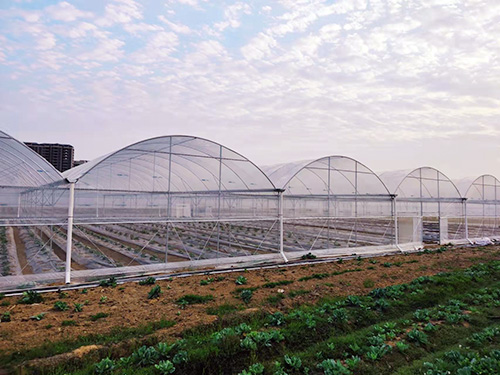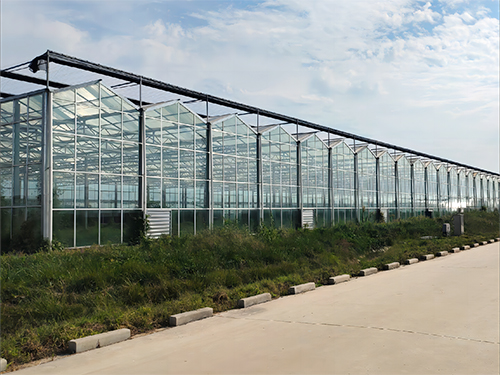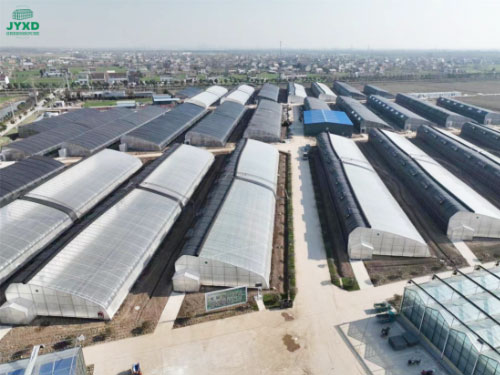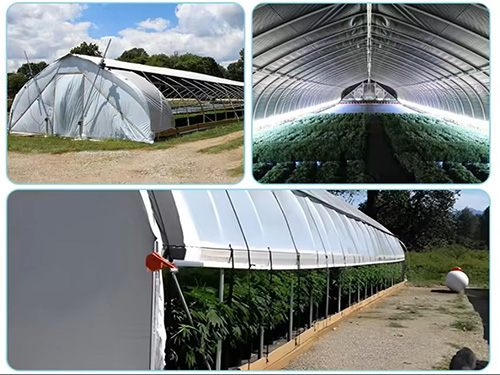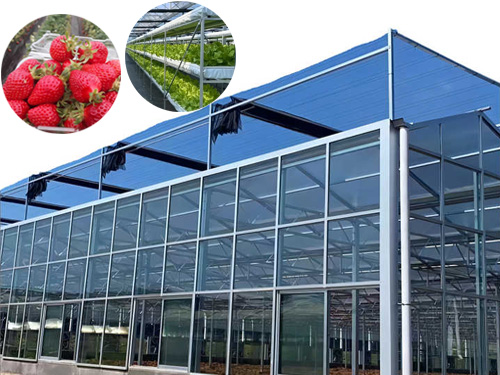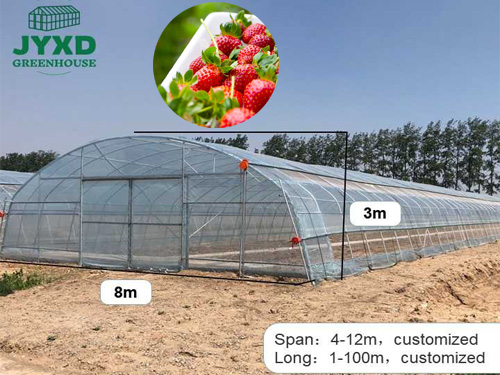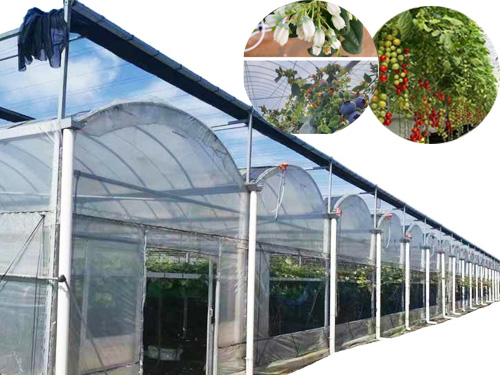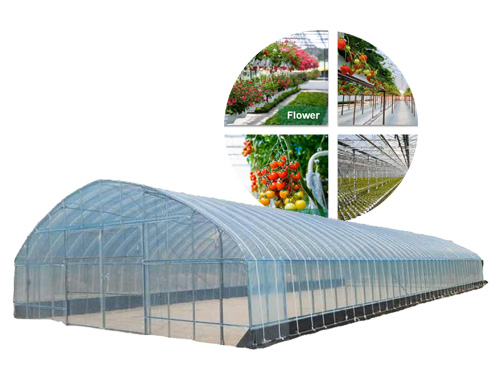NEWS DETAILS
NEWS INFORMATION
What to Do When the Temperature Is Too High in a Greenhouse? Effective Cooling Solutions
AUTHOR:jyxd-greenhouse DATE:2024-11-28 23:41:59 HITS:189
A greenhouse is an ideal place to provide plants with the appropriate growing environment, controlling factors such as temperature, humidity, and light. However, high temperatures inside the greenhouse are a common issue faced by many growers. High heat can not only hinder plant growth and photosynthesis but can also lead to stagnation or even death of the plants. To ensure healthy plant growth in the greenhouse, cooling becomes a critical management measure. This article will share several effective greenhouse cooling solutions to help growers create a more favorable growing space in hot environments.
1. Causes of High Temperatures in Greenhouses
The problem of high temperatures in a greenhouse is often related to the following factors:
a) Intense Solar Radiation
Greenhouse materials have strong light transmission, and when sunlight enters the greenhouse, the internal heat is not effectively dissipated, leading to rising temperatures.
b) Poor Ventilation
If the air inside the greenhouse does not circulate well, heat will accumulate, leading to localized high temperatures.
c) High Outdoor Temperatures and Lack of Shade
In summer or regions with hotter climates, rising outdoor temperatures directly affect the greenhouse temperature, especially when there is no shading system in place, causing a rapid temperature increase inside the greenhouse.
d) Heat Accumulation from Equipment
Greenhouse equipment such as lights, heaters, etc., can also increase indoor temperatures if they are not properly dissipating heat.
Keywords: Greenhouse cooling, causes of high temperatures, greenhouse equipment
2. Common Greenhouse Cooling Methods
To prevent high temperatures in the greenhouse, a series of effective cooling measures must be implemented. The following are some common cooling methods:
a) Natural Ventilation
Natural ventilation is one of the simplest and most environmentally friendly cooling methods. By opening windows, doors, or skylights, cooler outdoor air enters the greenhouse and carries away indoor heat.
Skylight Ventilation: Install openable skylights to allow hot air to rise and escape the greenhouse while cool air enters through side windows or doors, creating natural air convection.
Side Window Ventilation: Side windows can effectively draw in outside air, helping to accelerate air movement and prevent heat accumulation inside the greenhouse.
b) Installing Shade Nets
Shade nets can effectively reduce the amount of sunlight entering the greenhouse, lowering the light intensity inside and preventing overheating.
Choosing Shade Nets: Select shade nets with appropriate light transmittance based on the light needs of different crops. High light transmittance nets are suitable for light-tolerant plants, while low transmittance nets are better for crops that require less light.
Automated Shade Systems: Some modern greenhouses are equipped with automated shade systems that adjust the shade net openings based on external light intensity and internal temperature.
c) Misting for Cooling
Misting is an effective way to lower the temperature inside a greenhouse by increasing humidity. Misting devices spray water evenly into the air, and as the water evaporates, it carries away heat, resulting in cooling.
Atomizing Misters: Atomizing misters turn water into fine droplets that quickly evaporate and carry away heat, achieving rapid cooling.
Automated Misting Systems: Automated systems with humidity and temperature sensors can automatically trigger the misting devices based on changes in temperature and humidity.
d) Using Fans and Exhaust Systems
Fans and exhaust systems help by enhancing air circulation, expelling heat and humidity from the greenhouse, and maintaining a lower temperature.
Efficient Exhaust Fans: Using high-efficiency exhaust fans can quickly expel hot air from the greenhouse, drawing in cooler outdoor air and promoting air circulation inside.
Fan Layout: Proper fan placement ensures even airflow throughout the greenhouse, preventing hot spots.
e) Greenery and Plant Covering
Planting appropriate greenery can help cool the greenhouse through natural transpiration. Green plants not only beautify the environment but also lower the temperature by evaporating moisture during hot summer months.
Roof Greening: Planting grass or other suitable plants on the greenhouse roof can effectively reduce direct solar radiation, lowering indoor temperatures.
Vertical Greening: Planting greenery on the greenhouse walls can utilize the transpiration process of plants to regulate the indoor climate.
Keywords: Natural ventilation, mist cooling, fans and exhaust, shade nets
3. Using Temperature Control Systems for Intelligent Cooling
Modern greenhouses increasingly adopt intelligent temperature control systems to automatically adjust the environment. These systems can monitor temperature, humidity, light intensity, and other data in real-time and adjust the cooling measures in the greenhouse based on preset conditions.
a) Temperature Control Systems and Automated Management
Smart temperature control systems use temperature sensors, humidity sensors, and CO2 sensors to monitor the greenhouse environment in real-time and automatically trigger cooling measures based on data.
Temperature Control Valves and Fans: The system can automatically activate fans, exhaust systems, or shade nets to maintain the greenhouse temperature within an ideal range.
Data Analysis and Adjustment: The system can adjust based on real-time data and analyze past trends to predict future temperature changes, triggering cooling measures in advance.
b) Remote Control and Management
With the remote control functionality of temperature control systems, growers can monitor the greenhouse environment and make adjustments from anywhere, ensuring that the temperature inside the greenhouse remains within the desired range.
Smartphone Apps: Many temperature control systems provide smartphone applications that allow users to monitor temperature data and control greenhouse equipment remotely.
Keywords: Smart temperature control, automated management, remote control
4. Success Case: Practical Applications of Greenhouse Cooling
Case Overview: A greenhouse agricultural company successfully faced the challenges of high summer temperatures by implementing a comprehensive cooling plan.
Shade Nets and Misting Combination: The greenhouse installed high-efficiency shade nets combined with a misting system for cooling. The shade nets effectively reduced sunlight exposure, while the misting system quickly lowered temperatures through humidity control.
Automated Temperature Control System: The automated temperature control system ensured that the greenhouse temperature was always maintained within the ideal range.
Results: After implementing these cooling measures, the plant growing environment in the greenhouse improved significantly, leading to a notable increase in crop yield and quality.
Keywords: Greenhouse cooling case, greenhouse cooling effects
5. Conclusion
High temperatures greatly affect plant growth in greenhouses, making effective cooling measures crucial. By using appropriate natural ventilation, shade nets, misting, fans, and exhaust systems, the temperature inside the greenhouse can be significantly reduced, creating an optimal environment for plant growth. In addition, the application of modern smart temperature control systems provides a more refined and automated solution for cooling. Through these comprehensive measures, growers can effectively deal with the challenges posed by high temperatures, ensuring the healthy growth and high yield of plants.
Hebei Juyou Xinda Greenhouse Facilities Co.,Ltd.
Copyright © 2024-2025 https://www.jyxd-greenhouse.com. All Rights Reserved Hebei Juyou Xinda Greenhouse Facilities Co.,Ltd.Copyright





 Current Location:
Current Location: